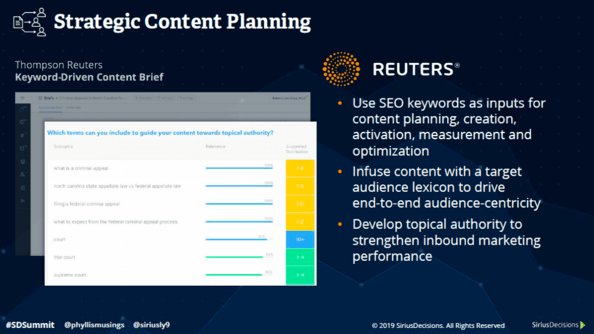High Performance Content Strategy and Operations Takeaway
There were a number of insightful presentations at SiriusDecisions 2019 Summit. One of my favorites was High Performance Content Strategy and Operations, with Phyllis Davidson and James Mathewson. Don’t worry if you missed it, because I took some notes!
The operating model of this presentation is that content is the fuel B2B engines uses to enhance the customer experience and that of its prospects. However, content teams frequently struggle to deliver that fuel.
The problem isn’t necessarily a lack of content creation resources. Rather, nascent teams don’t have the same skills; focusing their efforts on basic content strategy, management and operations.
High-performing content teams enjoy significantly higher rates of content utilization as a result of applying best practices throughout the content lifecycle. They key is linking the goals of content strategy and operations to specific business outcomes.
The presentation links high content usage to best practices based on data sets derived from the SiriusDecisions Command Center and the SiriusDecisions 2018 State of B-to-B Content Study. Here are some of those insights.
Characteristics of High-Performing Content Teams
76% of high-performing content teams use best-practice inputs to inform their content strategy.
Allow ample opportunity for all stakeholders involved in the content ecosystem to provide their input.
The types of input to seek out include audience definition, persona and buyer journey insights, campaign messaging, activation plans, and performance metrics. It’s especially important to bake KPIs into the plan at the program level.
High performers are 33% more likely to integrate SEO keyword strategy into the content lifecycle.
Organic search is a major component of most site’s traffic, so it makes sense to incorporate SEO keywords into all aspects of content.
Take it to the next level by imbuing your content with the language your audience uses. Create content strategically, covering all aspects of a topic. The more comprehensive your coverage of an issue, the more likely search engines will recognize your site as a topical authority.

Teams at leading companies are more than twice as likely to publish a global master content calendar.
Large and elaborate organizations have a great need for this editorial calendar, but its good practice to use on regardless of your team’s size.
Make sure this calendar is available to all the content stakeholders from which you originally sought input. Consider using content marketing or project management software to implement a calendar.
While standardization is helpful, different stakeholders will want to view this information in light of their priorities. Flexibility and interactivity are the key to making this work; avoid using a static calendar.
44% of high performers are more likely to use advanced analytics segmentation.
Segmentation provides a granular analysis of how well content performs and specifically in what areas it does best. Commonly used segments include audience, campaign, topic, channel, region, industry, and offering.
But don’t go out wildly selecting a bunch of metrics. Choose those that are appropriate to the stakeholder and provide quality insight for content planning.
Content teams performing at the highest level are 72% more likely to use modular content.
There are many benefits to be gained including advanced targeting and activation, improved consistency of messaging, content relevance and engagement.
Once again, a universal taxonomy, coupled with good tagging practices, helps ensure contextual relevance. Types of modular content include headline, subheadings, description, publish date, and call-to-action.
Service-level agreements (SLAs) are 73% more likely to be used, and adhered to, by high performers.
An SLA is part of content management best practices. But to increase the likelihood it will be followed, base SLAs on actual workflow data and factor in technology and third-party constraints.
For example, there is a certain element of control that is surrendered when tasks are outsourced. That timing of delivery needs to be accounted for in these situations. Don’t forget to include any dependencies such as budget and executive approval.
Content Strategy and Operations Next Steps
It’s time to take these observations and turn them into action. To enter the rarified world of high-performing content strategy and operations, the first step is to assess your organization’s functional maturity.
One way is to use the SiriusDecisions Scope of Content Strategy and Operations Model. Next, ensure everyone understands their cross-functional roles and responsibilities as it related to content.
Work to build topical authority using the language of your audience. Build measurement and reporting into your content plan.
Finally, the evolution will not happen as fast as you would expect. So, used a phased approach to ensure a successful transformation.
Stephen leads the content strategy blog for MarketMuse, an AI-powered Content Intelligence and Strategy Platform. You can connect with him on social or his personal blog.